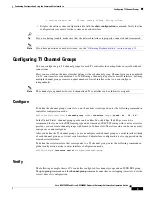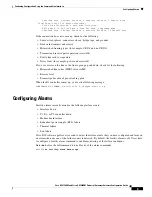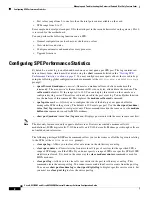
Continuing Configuration Using the Command-Line Interface
Configuring Alarms
9
Cisco AS5350XM and Cisco AS5400XM Universal Gateways Software Configuration Guide
0 Errored Secs, 0 Bursty Err Secs, 0 Severely Err Secs, 0 Unavail Secs
Total Data (last 13 15 minute intervals):
0 Line Code Violations, 0 Path Code Violations,
0 Slip Secs, 12 Fr Loss Secs, 0 Line Err Secs, 0 Degraded Mins,
0 Errored Secs, 0 Bursty Err Secs, 0 Severely Err Secs, 12 Unavail Secs
If the connection does not come up, check for the following:
•
Loose wires, splices, connectors, shorts, bridge taps, and grounds
•
Backwards transmit and receive
•
Mismatched framing types (for example, CRC-4 and no-CRC-4)
•
Transmit and receive pair separation (crosstalk)
•
Faulty line cards or repeaters
•
Noisy lines (for example, power and crosstalk)
If you see errors on the line or the line is going up and down, check for the following:
•
Mismatched line codes (HDB3 versus AMI)
•
Receive level
•
Frame slips because of poor clocking plan
When the E1 controller comes up, you see the following message:
%CONTROLLER-3-UPDOWN: Controller E1 0, changed state to up
Configuring Alarms
Facility alarms currently monitor the following failure events:
•
Interface down
•
T1, E1, or T3 controller down
•
Modem board failure
•
Redundant power supply (RPS) failure
•
Thermal failure
•
Fan failure
Cisco IOS software polls every second to detect the failure events that you have configured and turns on
an alarm when any one of the failure events is detected. By default, the facility alarm is off. Users have
to configure a facility alarm command to enable monitoring of the failure conditions.
Enter
no
before the full command to disable any of the alarm commands.
AS5350#
no facility-alarm detect rps





































